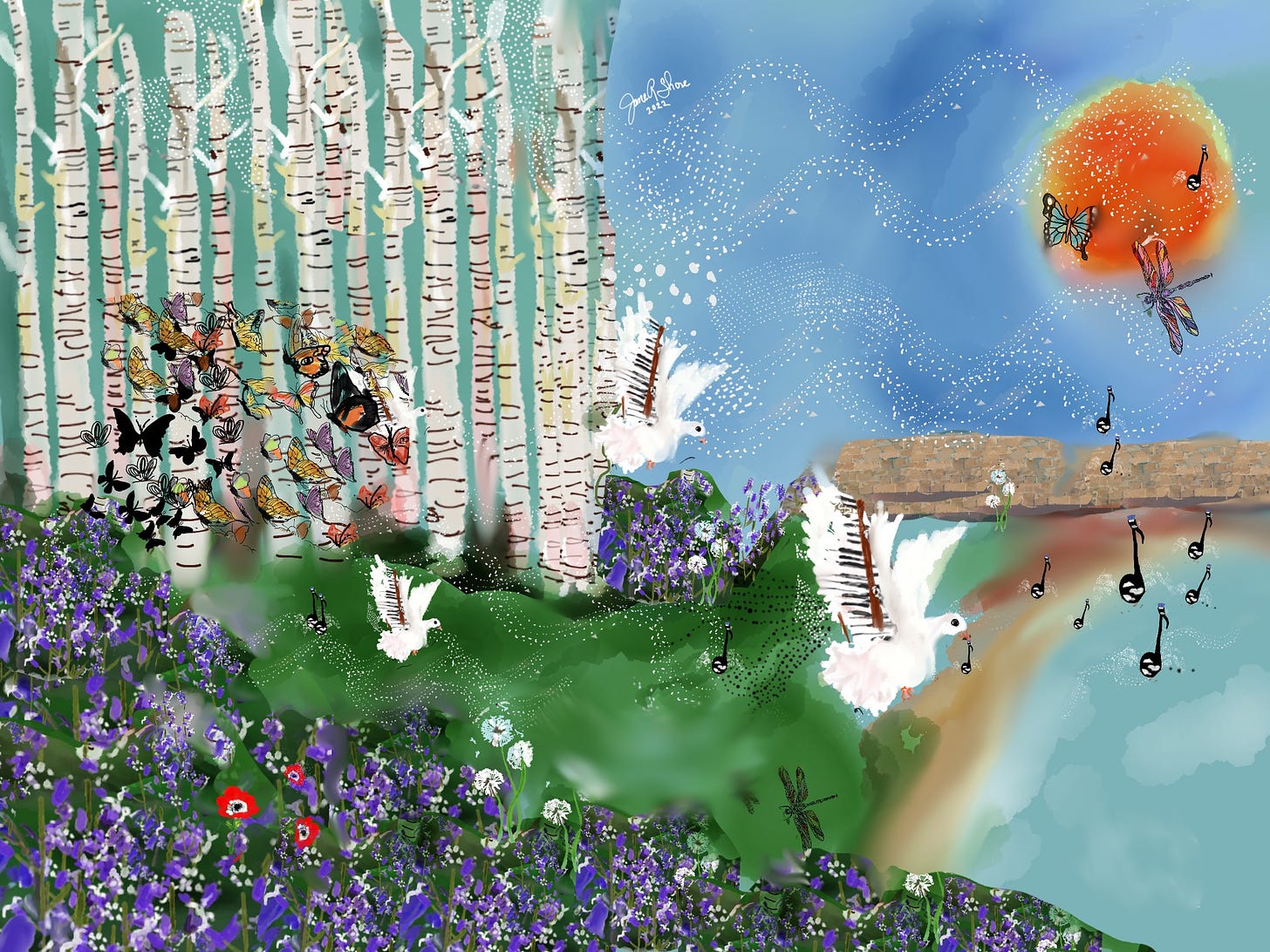Six key insights that remind us creativity is in us, and we can bring it out
This post features ideas and words from author, experienced educator and cross-cultural storyteller Melissa Campesi. Melissa and I recently collaborated on a children’s book, Imagine Song, released in October 2022. Her spirit, work and brilliant creative thinking inspires.
Creativity is one of those undeniably important skills, but it is hard to pin down and capture in ways that schools can describe. We celebrate its virtues, but holding it central to our work is something schools aren’t known for being good at.
When school is simply seen as a ticket to the future and not fuel for the present, anything overly creative, and not explicitly tied to grades or degrees, is seen as “extra.”
This is short sighted. There is an urgent need for:
- creative exposure,
- boundary lifting, and
- the creation of more creative spaces for a wider swath of young people.
By pushing against the (unwritten) rules of traditional school, we unlock new opportunities to act on what school could be.
The Big Idea(s)
Research (examples linked below) finds that creativity:
- fuels motivation
- grows self confidence
- lights up the brain
- spurs emotional development
- can ignite hard to reach students
- is essential for the future of work
Research by Dylan Wiliam and others has found that we need to model and explicitly teach creativity in all subjects. And we need many definitions of creativity.
Creativity in education may be seen as learning how and asking good questions, encouraging improvisation and feeding intuition. It delves deeply and takes time.
I like this paper by Daniel Willingham as a starting point for defining creativity.
You are thinking/working critically (or creatively) if (1) your thinking is novel—that is, you aren’t simply drawing a conclusion from a memory of a previous situation and (2) your thinking is self-directed — that is, you are not merely executing instructions from someone else and (3) your thinking is effective — that is, you respect conventions that make thinking more likely to yield useful conclusions.
And despite the criticism of current teaching practices, U.S. 15-year-olds scored above the international average on the most recent international assessment of creative problem-solving in 2012. The U.S. has long been seen as a leader in nurturing creative thinking in technology, business, and entertainment, prompting global educators to visit U.S. classrooms for clues to boosting creativity in their own classrooms.
So what do teachers do?

Before we go on, the story of the story of Imagine Song as a backdrop for this post.
Recently, Melissa A. Campesi and I engaged in a bucket list adventure. Melissa had written a story and she was looking for an illustrator (cue dreamy music). Inspired by her family’s own stories of immigration, and intertwined with her value on creativity, she had a memoir in the form of a children’s book. Her words needed visuals. Lifted by her gorgeous tale, illustrations started to flow. Melissa and I spent the summer of 2022 fueled by each other’s words (visual, textual and musical!) and produced this book.
We both share a common family journey of immigration (hers from Cuba, mine from Russia), with grandparents who had big dreams, and who valued the magic that comes with taking a leap to imagining more. The story, and our book, is intentionally seeking to have all readers see their diverse selves in a story about leaning in to creative magic.1
 Imagine Song is about what happens when we abandon our sheet music (once we’ve learned it), and play from our hearts.
Imagine Song is about what happens when we abandon our sheet music (once we’ve learned it), and play from our hearts.Making Big Ideas Usable
Using Imagine Song as a prompt, Melissa and I recently co-hosted (truth: she hosted and I tried to learn quickly & improvise!) a twitter chat to collect insights into diverse places for creativity. This post shares several takeaways from the conversation.
Modeling modes of creativity during instruction aids in opening student creative channels. A question Melissa asks: “What creative inputs am I implementing into my lesson to enhance learning and have it accessible for every student?”
The more students are exposed to a multimodal creative approach, the more confident they will be in using their creativity because it will be mirrored in instruction.
Melissa recommends that grading rubrics and standards must NOT be binding, but boundless. Students should not feel constrained to show their learning. This causes stress and anxiety to please the teacher in exchange for a “good” grade. More here.
Student projects should be encouraged to look, be shared, and assessed differently from everyone else in the class.
Making guidelines for projects and assignments more flexible, open and iterative allows lessons to go to unexpected, but no less rigorous, places.
Examples: Instead of encouraging learners to copy or memorize facts, suggest they present a variation on a theme. Reimagine a historical scene if events had gone differently, recreate a famous painting from a different vantage point, or write a story from the perspective of a minor character. Same learning standards, unique, creative and sometimes improvised perspective.
We all tend to make a pedagogical mistake by emphasizing the answering and not the asking of questions. It’s less about right answers, and more about right questions. Make questioning a part of the daily classroom exchange. It is more important for students to learn what questions to ask – and how – than to learn the answers.
When teachers express the desire to learn alongside students, they open pathways for young people to share theirs.
Six Ways to Bring out the Creativity in Schools, by educators around the country
- Creative input is needed for creative output.
- Authentic assessment breeds creativity.
- Words matter.
- Flexible guidelines allow for improvisation.
- Questioning skills are a door to creativity.
- Representing your own creativity matters.
What would you add?
